Accepted Scientific Name: Discocactus placentiformis (Lehm.) K.Schum.
Nat. Pflanzenfam. Nachtr. [Engler & Prantl] iii. 6 a. (1894) 190.
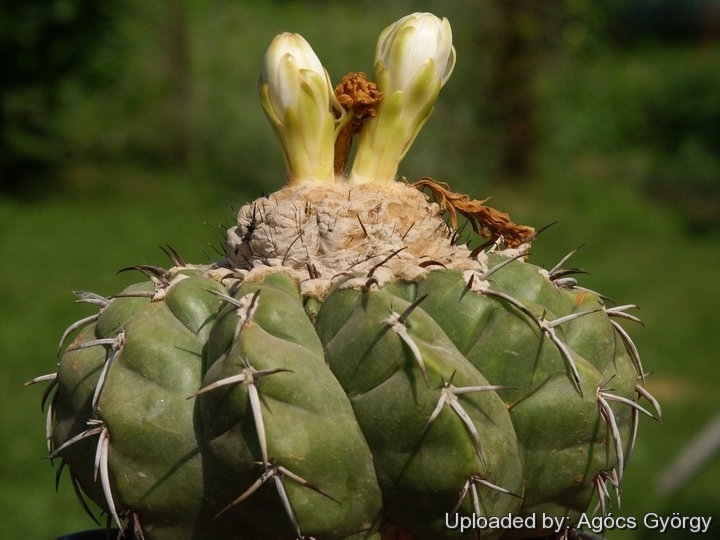
Discocactus tricornis Photo by: Agócs György
At Rebutialand cactus collection Demjén, Hungary.
Origin and Habitat: Eastern central Brazil (Mato Grosso?), Brazil
Synonyms:
See all synonyms of Discocactus placentiformis
back
Accepted name in llifle Database:Discocactus placentiformis (Lehm.) K.Schum.Nat. Pflanzenfam. Nachtr. [Engler & Prantl] iii. 6 a. (1894) 190.Synonymy: 26
back
Description: Discocactus tricornisSN|1433]]SN|1433]] is usually given as a synonym of Discocactus alteolens, which should have 5 or 6 radial spines instead of the 3 radial spines typical of D. tricornis. Possibly the plant bearing only 3 radial spines named D. tricornis is only a juvenile forms with fewer spines of the otherwise identical Discocactus placentiformisSN|1430]]. Nowadays this plant name is not accepted by botanists that treat it as synonym of Discocactus placentiformisSN|1430]], but it still has a value for a collector because they identify plants with particular characters. A tree spined “D. tricornis” has been commercialized by the cactus collector Karel Kníže (field number KK 668).
Stem: Solitary, broader than high, dull gray, crowned by a broad cephalium.
Ribs: 9 or 10, broad at base, low.
Radial spines: Typically Discocactus alteolens has 5 or 6 radial spines (whereas Discocactus tricornisSN|1433]]SN|1433]] has mostly only 3), the 3 lowermost stout, one of which noticeably longer, bent downwards; the 2-3 upper ones (if present), very short, ascending.
Central spines: None or rarely solitary and porrect.
Flowers: Salverform; tube slender, bearing slender scales with naked axils; inner perianth-segments white, numerous, obtuse; ovary naked, glabrous.
Subspecies, varieties, forms and cultivars of plants belonging to the Discocactus placentiformis group
 Discocactus crystallophilus Diers & Esteves: has (3)5-7 brown-reddish to pale grey spines, lateral to 2 cm long, lowermost one to 3 cm long. Uppermost about 5 mm long. Distribution: Minas Gerais.
Discocactus crystallophilus Diers & Esteves: has (3)5-7 brown-reddish to pale grey spines, lateral to 2 cm long, lowermost one to 3 cm long. Uppermost about 5 mm long. Distribution: Minas Gerais.  Discocactus insignis Pfeiff.: has 5 to 7 spines of which the lowest one more long and recurved backwards to the plant. Distribution: neighbourhood of Grao Mogol, Minas Gerais, Brazil.
Discocactus insignis Pfeiff.: has 5 to 7 spines of which the lowest one more long and recurved backwards to the plant. Distribution: neighbourhood of Grao Mogol, Minas Gerais, Brazil. Discocactus latispinus Buining ex Bredero ex J.Theun.: has 5 spines of which the lowest one more long and characteristically flattened. distribution: Joaquim Felicio and adjacent areas, Minas Gerais.
Discocactus latispinus Buining ex Bredero ex J.Theun.: has 5 spines of which the lowest one more long and characteristically flattened. distribution: Joaquim Felicio and adjacent areas, Minas Gerais. Discocactus multicolorispinus P.J.Braun & Bredero: spines mostly amber like, but variable in colouration (multicolored) hence the name. Distribution: Serra do Espinhaco in Minas Gerais. Brasil.
Discocactus multicolorispinus P.J.Braun & Bredero: spines mostly amber like, but variable in colouration (multicolored) hence the name. Distribution: Serra do Espinhaco in Minas Gerais. Brasil. Discocactus placentiformis (Lehm.) K.Schum.: is a small flattish globular cactus, with woolly cephalium. It is one of the most widely distributed and variable species. Distribution: whidespread in Minas Gerais.
Discocactus placentiformis (Lehm.) K.Schum.: is a small flattish globular cactus, with woolly cephalium. It is one of the most widely distributed and variable species. Distribution: whidespread in Minas Gerais. Discocactus placentiformis var. minor-horridulus n.n.: has smaller stems, with 5(-7) spines of which the lowest one more long and flattened. Flower often pink in the exterior. Distribution: Diamantina, Minas Gerais, Brazil.
Discocactus placentiformis var. minor-horridulus n.n.: has smaller stems, with 5(-7) spines of which the lowest one more long and flattened. Flower often pink in the exterior. Distribution: Diamantina, Minas Gerais, Brazil. Discocactus pulvinicapitatus Buining & Bredero: is very similar to Discocactus latispinus, but is larger size and has a larger cephalium. Distribution: Central part of Minas Gerais, Brazil.
Discocactus pulvinicapitatus Buining & Bredero: is very similar to Discocactus latispinus, but is larger size and has a larger cephalium. Distribution: Central part of Minas Gerais, Brazil. Discocactus tricornis Monv. ex Pfeiff.: has 3 radial spines pointing downward, occasionally accompanied by 2-3 very short spines pointing upward. (same as Discocactus alteolens?). Distribution. Eastern central Brazil.
Discocactus tricornis Monv. ex Pfeiff.: has 3 radial spines pointing downward, occasionally accompanied by 2-3 very short spines pointing upward. (same as Discocactus alteolens?). Distribution. Eastern central Brazil.
Bibliography: Major references and further lectures
1) Curt Backeberg “Blätter für Kakteenforschung: Bulletin of cactus research” Bez. Hmb. Deutschland., 1934
2) N. L. Britton, J. N. Rose “The Cactaceae. Descriptions and Illustrations of Plants of the Cactus Family.” Volume 3, The Carnegie Institution of Washington, Washington 1922
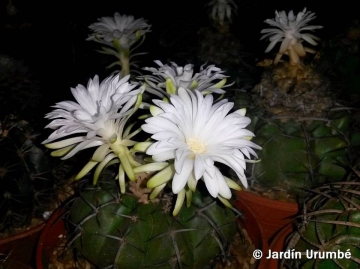 Discocactus tricornis Photo by: Alexander Arzberger
Discocactus tricornis Photo by: Alexander Arzberger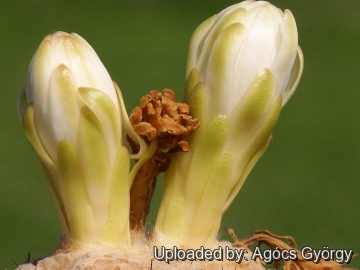 At Rebutialand cactus collection Demjén, Hungary. Photo by: Agócs György
At Rebutialand cactus collection Demjén, Hungary. Photo by: Agócs György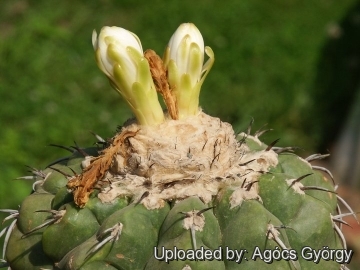 At Rebutialand cactus collection Demjén, Hungary. Photo by: Agócs György
At Rebutialand cactus collection Demjén, Hungary. Photo by: Agócs György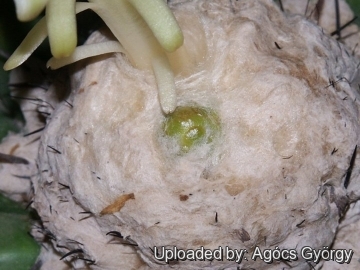 At Rebutialand cactus collection Demjén, Hungary. Photo by: Agócs György
At Rebutialand cactus collection Demjén, Hungary. Photo by: Agócs György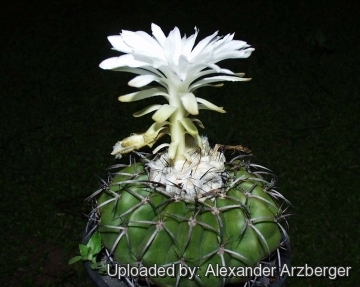 Discocactus tricornis Photo by: Alexander Arzberger
Discocactus tricornis Photo by: Alexander ArzbergerSend a photo of this plant.The gallery now contains thousands of pictures, however it is possible to do even more. We are, of course, seeking photos of species not yet shown in the gallery but not only that, we are also looking for better pictures than those already present.
Read More... Cultivation and Propagation: Discocactus tricornis is not the easiest plant to keep happy, so it isn't a plants for beginners, in fact collectors consider the Discocactus to be rarities which requires skilful cultivation. Under glass, it isn't difficult, but appreciates milder winter temperatures and more generous summer watering than most of the other genera of compact cacti. When grown to maturity, however, it possess an exotic look shared by no other cacti, and it generally attract a lot of attention.
Growing rate: It is slow growing.
Soil: It likes very porous standard cactus mix soil. Prefer a low pH compost, avoid substrata rich in limestone; otherwise growth will stop altogether.
Repotting: They generally resent being repotted and can take a long time to establish.
Fertilization: Feed with a high potassium fertilizer in summer.
Exposition: The plant tolerates bright situations but enjoys filtered sunlight or afternoon shade, inside it needs bright light, and some direct sun. Tends to bronze in strong light, which encourages flowering and heavy spine production.
Waterings: Discocacti are very rot prone when kept on their own roots and though they can’t endure long stretches of total dryness, too much water with cool will rot them, as their weak root systems tend to be inefficient at sucking up water from wet soil.
Hardiness: It is rather difficult to grow and frost tender, it can’t stand cold, or even fairly cool temperatures and should be kept at above 15° C if grown on its own roots (8°C if grafted).
Uses: It is an excellent plant for container growing. It always looks good and stays small.
Pests & diseases: It may be attractive to a variety of pests or diseases:
- Red spiders: Red spiders may be effectively rubbed up by watering the plants from above.
- Mealy bugs: Mealy bugs occasionally develop aerial into the new growth among the wool with disfiguring results, but the worst types develop underground on the roots and are invisible except by their effects.
- Scales: Scales are rarely a problem.
- Rot: Rot it is only a minor problem with cacti if the plants are watered and “aired” correctly. If they are not, fungicides won't help all that much.
Propagation: Seeds or grafting. Seeds germinate in 7-14 days at 21-27° C in spring, remove gradually the glass cover as soon the plants will be well rooted (ca 1-2 weeks) and keep ventilated, no full sun for young plants! .Young seedlings are often grafted on a low stock to keep the plant in a good shape.
















